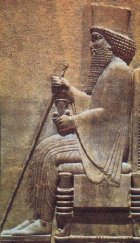| Please Note: This page is part of the Book of Darius website. The primary subject of this page and the parent site is the fictional character Darius from the television series Highlander, not King Darius the Great of Persia or any other person, real or imagined, by the name of Darius. |
 Darius (Greek form Dareios) is a classicized form of the Old Persian Daraya-Vohumanah,
Darayavahush or Darayavaush, which was the name of three
kings of the Achaemenid Dynasty of Persia: Darius I (the Great), ruled
522-486 BCE, Darius II (Ochos), ruled 423-405/4 BCE, and Darius III (Kodomannos),
ruled 336-330 BCE. In addition to these, the oldest son of Xerxes I was
named Darius, but he was murdered before he ever came to the throne, and
Darius, the son of Artaxerxes II, was executed for treason against his own father.
Darius (Greek form Dareios) is a classicized form of the Old Persian Daraya-Vohumanah,
Darayavahush or Darayavaush, which was the name of three
kings of the Achaemenid Dynasty of Persia: Darius I (the Great), ruled
522-486 BCE, Darius II (Ochos), ruled 423-405/4 BCE, and Darius III (Kodomannos),
ruled 336-330 BCE. In addition to these, the oldest son of Xerxes I was
named Darius, but he was murdered before he ever came to the throne, and
Darius, the son of Artaxerxes II, was executed for treason against his own father.
According to A. T. Olmstead's book History of the Persian Empire, Darius the Great's father Vishtaspa (Hystaspes) and mother Hutaosa (Atossa) knew the prophet Zarathustra (Zoroaster) personally and were converted by him to the new religion he preached, Zoroastrianism. (For more information on the religion, try this link). Not long after this conversion, in 550 BC, their first son was born, and in honor of Ahura Mazda, the Wise Lord of Zoroastrianism, Vishtaspa named the boy Daraya-Vohumanah "Who Sustains Good Thought". (Good Thought was a part of the doctrine of Zoroastrianism, and an attribute of Ahura Mazda). Other interpretations of the name are similar: "He Who Upholds the Good" and "To Possess Good". (The actual time period during which Zarathustra lived is a matter of great speculation, but few satisfactory answers. One native tradition has it that he was alive 258 years before Alexander the Great conquered Persia in 331 BCE, but many scholars believe that the Gathas, which the prophet was said to have composed himself, date back as far as 1200-1000 BCE, well before the rule of the Achaemenid kings. Whether or not Darius' father knew Zarathustra, he obviously felt strongly enough about his teachings to name his son as he did). Later, when Darius ascended the throne of Persia, (see bas-relief portrait above) he had many inscriptions carved to document his accomplishments, which, he said, were achieved "in the protection of Ahura Mazda", "by the favor of Ahura Mazda", and "with those skills which Ahura Mazda has bestowed upon me." As King, Darius established a code of laws based on Hammurabi's, which he called the Ordinance of Good Regulations, and he declared Zoroastrianism the state religion. By all accounts he was a good ruler and administrator, and tolerant of other religions in countries encompassed by his Empire, which extended all the way to Northern India. Darius the Great and the other Achaemenids of that name all lived hundreds of years before the Darius of Highlander was born in the first century CE. No explanation has been given so far in the series as to how a Goth warlord came to bear the name of a Persian king. We do not know if Darius was his original name, or if he adopted it later, or was given it later by someone else. His first teacher was one Ahasuerus the Parthian, and Parthia was part of the Persian Empire. It is possible he might have bestowed the name on his student. Or perhaps Darius had travelled to Persia or countries under her rule, and took the name for himself. Or he could have simply heard of Darius the Great and decided the name had a nice ring to it. But however he got his name, it seems an almost prophetic choice when you consider what happened to Darius after he took the Quickening of the Holy Man at Paris. He became, in truth, "He Who Sustains Good Thought" and "He Who Upholds the Good." |
 |
The Book of Darius URL: https://www.angelfire.com/film/bookofdarius/ Webmaster: tirnanog (This page last updated 04/11/2004) |